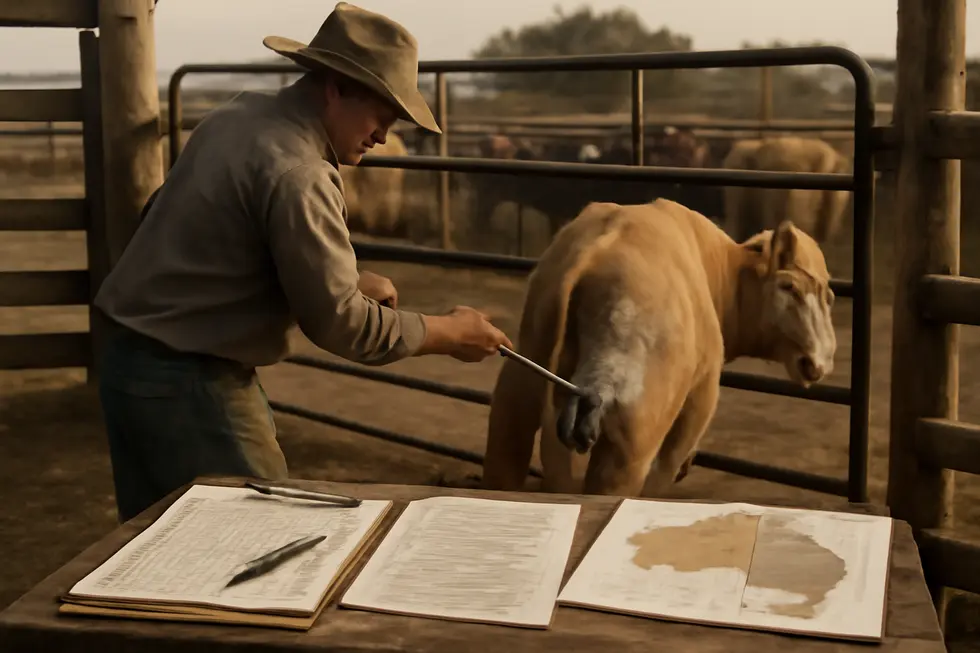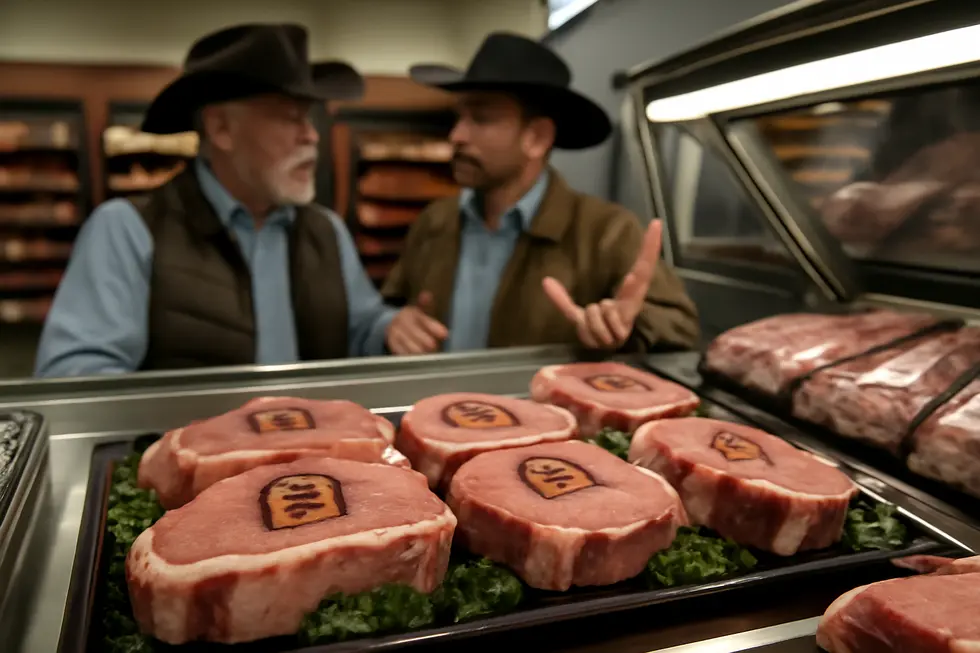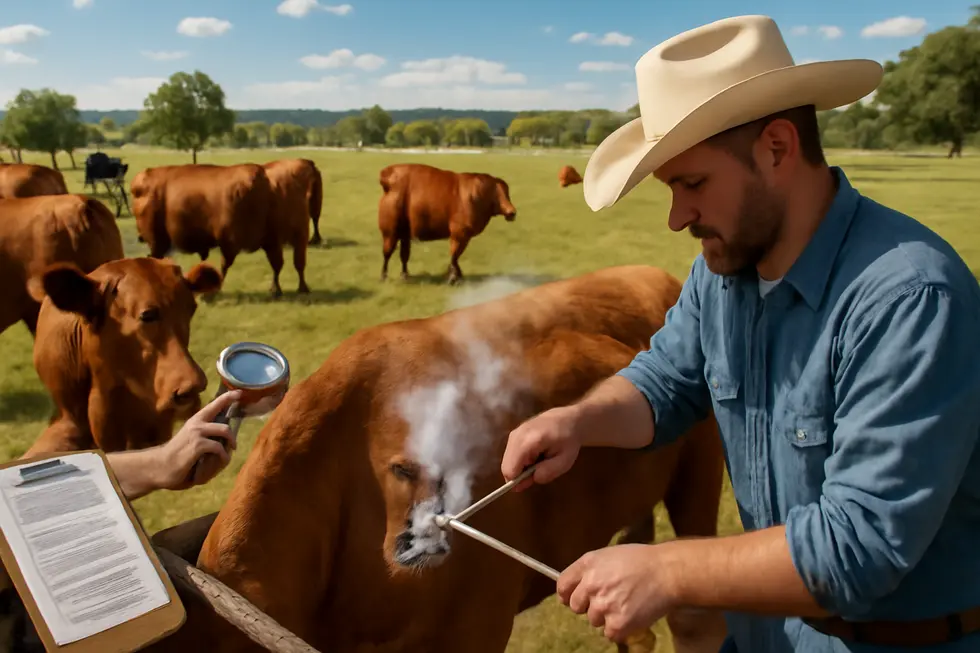导言
品牌牛是牲畜管理的基石,将传统、法律必要性和现代市场战略融为一体。通过独特而永久的标记来确认所有权,不仅能保护资产,还能确保遵守牛只交易和放牧的监管框架。了解各种烙印方法--从传统的烫印到最先进的电子识别--使企业主能够选择适合其运营需求的解决方案。此外,利用烙印牛作为质量标志,可以提升市场影响力并获得溢价。本文每一章都深入探讨了这些重要方面,提供了一个全面的视角,将所有权保护、法律遵守、技术进步和战略营销统一在品牌牛这一主题之下。
目录
第 1 章:品牌牛所有权识别和法律规定
- 将传统技术与现代技术相结合,促进牛的烙印和法律合规性
- 品牌牛所有权的法律和经济基础
- 牛烙印和识别法的地缘政治影响和社会冲击
第 2 章:牛的烙印:烙印方法和技术
- 从热烙铁到微芯片:牛烙印的演变与技术
- 塑造牛品牌的创新:从传统标记到数字识别
- 驾驭牛烙印的法律和文化层面:传统、福利和识别技术
第 3 章:作为质量和营销工具的品牌牛
- 牛烙印的永恒遗产:从所有权标志到质量象征
- 利用数据技术提升品牌牛质量和市场信任度
- 通过品牌牛推动经济增长和市场稳定
第 1 章:品牌牛所有权识别和法律规定

1.传统与现代技术在牛烙印和法律合规方面的结合
牛只所有权识别将历史悠久的烙印技术与先进的技术相结合,确保标记清晰、可验证,并符合法律标准。传统的热烙印和冷冻烙印仍然是基础;热烙印会在牛皮上留下永久性疤痕,而冷冻烙印则会改变牛毛色素,从而提高可见度,减少动物的不适感。作为补充,耳标提供了一种具有成本效益且不受天气影响的物理标识,广泛用于追踪和所有权验证。植入式 RFID 微型芯片可提供精确的电子识别,实现自动跟踪和数据管理,已在不同地区获得法律认可。耳朵或嘴唇内的纹身主要用于奶牛,提供了一种微妙但永久的识别形式。最近,人工智能驱动的人脸识别技术正在成为一种非侵入式的替代方法,使饲养者能够在没有物理设备的情况下监控动物的健康和行为,从而有可能改变未来的牲畜管理。法律框架要求采用特定的识别方法来打击盗窃行为并简化监管,许多司法管辖区都强制执行标记和烙印协议。这些系统将物理烙印与电子和人工智能技术相结合,可加强所有权证明、促进动物福利并支持全面的畜群管理。有关合法保护所有权标识符的更深入见解,请参阅以下讨论 受法律保护的品牌商标.有关国家牲畜识别法规的更多信息,请访问 牲畜管理中的新兴人工智能和传感器技术.
2.品牌牛所有权的法律和经济基础
给牛打上烙印不仅是一种传统的识别做法,也是法律认可的牲畜所有权和经济价值的基石。注册烙印是将牲畜与其所有者联系起来的永久标记,确立了明确的个人财产权。通过由政府当局维护的官方登记处,烙印提供了一个法律框架,使所有者能够行使其权利,对盗窃或未经授权的使用提起诉讼,并通过销售或继承转让所有权。这种记录在案的烙印就像地契一样,法律通常会规定收取费用和定期更新。
此外,在公开放牧或参与商业交换时,法规可能会要求牛只打上烙印,从而加强了烙印在防止纠纷和提高可追溯性方面的作用。虽然微芯片和人工智能识别等新兴技术越来越多地被用于牛群管理,但传统的烙印因其成本效益、永久性和司法认可而继续存在。归根结底,牛烙印的法律和经济功能相互交织,可确保所有权利益,促进市场交易,维护牲畜管理的完整性。有关烙印登记和执行的权威法律概述,请参见威斯康星州法规第 95 章(2025 年)。这凸显了烙印如何在规范的牲畜市场中发挥重要作用,将经济价值与法律承认直接联系起来。
如需了解与所有权商标相关的知识产权保护的更多信息,请访问 受法律保护的品牌商标.
3.牛烙印和识别法的地缘政治影响和社会冲击
牛烙印和识别法的地缘政治影响和社会冲击
以法律法规为基础的品牌牛识别系统,其影响力远远超出了单个农场。这些系统,如国家牲畜识别计划,能够持续追踪牲畜的所有权和流动情况。这种可追溯性对于控制疾病爆发,从而保障贸易关系和达到国际生物安全标准至关重要。在地缘政治方面,可靠的牲畜身份识别有助于提高国家参与全球市场的能力,同时保护国内农民免遭盗窃和欺诈。
在社会层面上,清晰的身份识别通过验证产地和健康状况,增强了消费者对食品供应的信心,符合人们对透明度和动物福利日益增长的需求。人工智能辅助光谱识别等新兴技术有望降低侵入性,提高道德标准和准确性。同时,管理品牌的法规反映了更广泛的治理问题,包括抗菌药耐药性和可持续农业,这将农业实践与更广泛的政治和经济框架联系在一起。
归根结底,这些法律框架所做的远不止是标明所有权,它们还加强了农业治理,巩固了农村经济,影响了国际贸易动态,体现了牛的品牌和标识如何与社会秩序和地缘政治战略相互交织。
有关保护相关行业所有权和产权的更多信息,请参阅 品牌商标商业保护.
参考资料:国家牲畜识别系统(澳大利亚) https://www.nlis.com.au/
第 2 章:牛的烙印:烙印方法和技术

1.从热熨斗到微芯片:牛烙印的演变与技术
牛的烙印已经从古老的必要做法演变为兼顾传统、福利和技术的多种识别方法。最早也是最经久不衰的技术是热铁烙印法,它是将加热的金属印章压在牛皮上,形成永久性的疤痕。这种方法与牧场传统密不可分,特别是受西班牙伐克洛人(Vaqueros)的影响,它能提供一眼就能识别的标记,以证明所有权并阻止盗窃。然而,由于烙印的痛苦和对牛皮的损害,冷冻烙印等创新方法应运而生。冷冻烙印使用过冷金属杀死皮下色素细胞,使该区域的毛发变白。冷冻烙印的烙印效果明显,痛苦较少,外观独特,对深色皮毛尤其有效。作为这些物理方法的补充,纹身烙印通过在耳朵或嘴唇内注射墨水,提供了一种侵入性较小的永久性标识,主要用于奶牛。虽然油漆烙印提供的临时标记在某些情况下有用,但它们的不稳定性限制了其广泛采用。在烙印技术的前沿,植入式微型芯片转发器有助于对动物进行精确跟踪和数据收集,但由于成本和文化因素,其普及程度仍然较低。尽管技术在不断进步,但传统的烙印方法依然存在,它们将实用性、法律认可和文化传承融为一体。要进一步了解经典和创新的烙印工具,视频概述 "什么是烙铁?"等教育资源提供了宝贵的见解。
2.塑造牛品牌的创新:从传统标记到数字识别
牛的烙印已经从传统的使用加热烙铁发展到更先进、更人道的方法,如冷冻烙印和数字识别技术。传统的热铁烙印会灼伤牛皮,留下永久的印记,往往会给牛带来极大的痛苦和压力。相比之下,冷冻烙印使用过冷的金属印章改变毛发色素细胞,产生可见的白色烙印,减少动物的不适感,并保持皮肤的完整性。作为这些方法的补充,电子识别技术(如 RFID 标签、植入式微芯片和电子耳标)可对牛只进行精确的数字化追踪。这些创新技术通过提供准确的健康监测、疾病控制和增强整个供应链的可追溯性,促进了牛群管理的改善--这是保证食品安全的关键因素。将传统烙印与电子识别相结合的混合系统提供了一种实用的平衡,既尊重了悠久的牧场传统,又整合了尖端技术,提高了运营效率和福利标准。因此,烙印方法的多样化反映了养牛业向更加道德和数据驱动型实践的广泛转变。为了更清楚地了解烙铁的演变,视频 "什么是烙铁?
3.牛烙印的法律和文化导航:传统、福利和识别技术
给牛打上烙印远不止是给牲畜做标记,它还涉及法律规定、经济实用性以及深深植根于牧场历史的文化传统。许多司法管辖区都要求给牛打上烙印,以核实所有权和防止偷盗,并通过法律规范烙印的注册和放置,以保护所有者和畜牧业。在经济上,烙印仍然是管理大型牛群的一种成本效益高、经久耐用的方法,尽管技术在不断进步,但它仍能让牧场主有效地跟踪牲畜并保持准确的记录。
在文化上,烙印象征着牧场社区的传统和身份,强化了所有权和传承感。然而,对动物福利的担忧促使人们进行创新,如冷冻烙印,这种方法使用过冷的烙铁去除毛囊中的色素,在减少痛苦的同时留下明显的痕迹。包括纹身和微芯片等电子识别在内的替代方法提供了侵入性较小的选择,但往往由于成本和文化接受度的原因,尚未广泛取代传统的烙印。
这些做法既兼顾了传统、法律合规性和动物福利,又适应了支持牛业可追溯性和食品安全标准的新兴技术。如需深入了解烙印的实用性和福利性,请参阅 这一专家资源.
第 3 章:作为质量和营销工具的品牌牛

1.牛烙印的永恒遗产:从所有权标志到质量象征
长期以来,给牛打烙印一直是一种重要的习俗,深深植根于历史和传统之中。其起源可追溯到公元前 2300 年左右的古埃及,那里的早期描述显示牛被打上烙印,这种方法最初是为了维护所有权。这种做法跨越大陆和世纪,逐渐发展成为牧牛文化的一个显著特征,尤其是在美国西部。南北战争后,出现了正式的烙印登记制度,以从法律上保护所有权并阻止盗窃。除了法律功能外,烙印还成为家族传承和品质的象征。牧场主们通过独特的符号向购买者传达值得信赖和优良种畜的信息,从而培养了自己的声誉。这些标志是早期的质量保证工具,使消费者能够将特定品牌与管理良好的牛群和更健康的牲畜联系起来,从而帮助牧场主获得更高的价格。尽管基因和技术在不断进步,但这一传统仍在影响着今天的牛只营销方式。品牌所蕴含的文化意义经久不衰,在畜牧业中颂扬着血统和工艺。曼科斯山谷品牌项目(Mancos Valley Brand Project)以详尽的历史视角和对这一传统的致敬,展示了品牌是如何保留牧场身份和讲述故事的。欲了解与品牌相关的知识产权保护,请参阅企业注册商标的好处。
2.利用数据技术提升品牌牛质量和市场信任度
数据驱动技术的整合正在重塑品牌牛的质量和市场价值。先进的人工智能和物联网系统可实现实时健康监测,在没有侵入性设备的情况下及早发现细微的行为变化和疾病。这种积极主动的动物健康状况可减少损失,确保牛群更健康,从而直接提高与牛品牌相关的产品质量。此外,区块链提供了一个不可更改的分类账,可以透明地追踪牛的血统、健康历史和可持续发展实践。这种可追溯性通过验证真实性和道德方面的声明增强了消费者的信心,这对优质品牌至关重要。由人工智能驱动的自动质量控制进一步确保了标准的一致性,最大限度地减少了人为错误,提高了食品安全--这是保护品牌声誉的关键。通过数字平台,生产商可以直接与消费者联系,定制以可持续发展、动物福利和卓越产品为重点的营销信息。数据分析还能让生产商深入了解如何优化定价和采购策略,从而在竞争激烈的市场中强化品牌定位。行业团体与技术提供商之间的合作创建了强大的平台,通过经过验证的来源提高了市场准入和品牌可信度。这些创新共同将牛的品牌从单纯的所有权标志转变为一个动态的、数据丰富的工具,将透明度、真实性和质量嵌入品牌牛的身份之中。这一演变为消费者的持续信任和优质市场吸引力提供了支持。要深入了解如何保护品牌的完整性,请了解以下方面的优势 受法律保护的品牌商标.
3.通过品牌牛推动经济收益和市场稳定
牛的品牌不仅仅是一种传统的识别方法,它还从根本上影响着牛肉行业的经济成果和市场动态。通过将特定的品种或基因品质(如安格斯血统)与可识别的品牌联系起来,生产商可使其产品与众不同,并获得反映其肉质优越性的溢价。例如,与无品牌的同类产品相比,具有安格斯基因的杂交小牛犊售价明显更高,这突出说明了品牌是如何扩大收入来源的。这种市场差异促进了消费者的信任,使需求即使在供应短缺时也能保持旺盛,因为忠实的买家会从品牌来源寻求质量稳定的保证。此外,品牌牛通过鼓励与品牌标准相一致的有针对性的育种实践,提高了供应链的整合能力,而包装商则看重产品的统一性和市场吸引力。然而,依赖于狭窄的品种重点可能会带来管理上的挑战,如果替代存栏量变得稀缺,牛群的可持续性就会面临风险。尽管存在这些风险,但战略性地使用品牌牛显然能提高经济回报,并通过质量信号和促进生产加工线的协作来稳定市场。这凸显了品牌不仅在所有权识别方面,而且在加强牛肉市场弹性和盈利能力方面的重要作用。有关通过商标和品牌识别保护商业利益的更多见解,请参见 本资源.更多有关市场在近期牛荒中的恢复能力的信息,请访问 这里.
最后的想法
品牌牛代表的不仅仅是所有权标志,它们还是畜牧业成功不可或缺的战略资产。通过将牛的永久标识与地区法律框架相协调,企业主可以保护他们的投资,防止盗窃或纠纷。了解各种不同的烙印方法--从传统的烙铁到创新的电子标识--可以根据不同的经营情况和动物福利考虑采取量身定制的方法。此外,利用烙印作为质量的象征,还能提供无与伦比的营销优势,使生产商能够区分自己的牲畜并进入优质市场。最终,通过品牌牛将所有权保护、先进的品牌技术和战略营销融为一体,创造出一种具有弹性、盈利性和可持续性的畜牧业商业模式。
今天就申请商标!成千上万的人通过申请商标保护了自己的品牌。您还在等什么?开始申请商标吧!
关于我们
全球顶级商标注册网站,保护您的品牌、名称、徽标或口号。我们提供简单、经济、安全的在线商标注册服务,旨在保护您的知识产权,促进您的业务发展。







